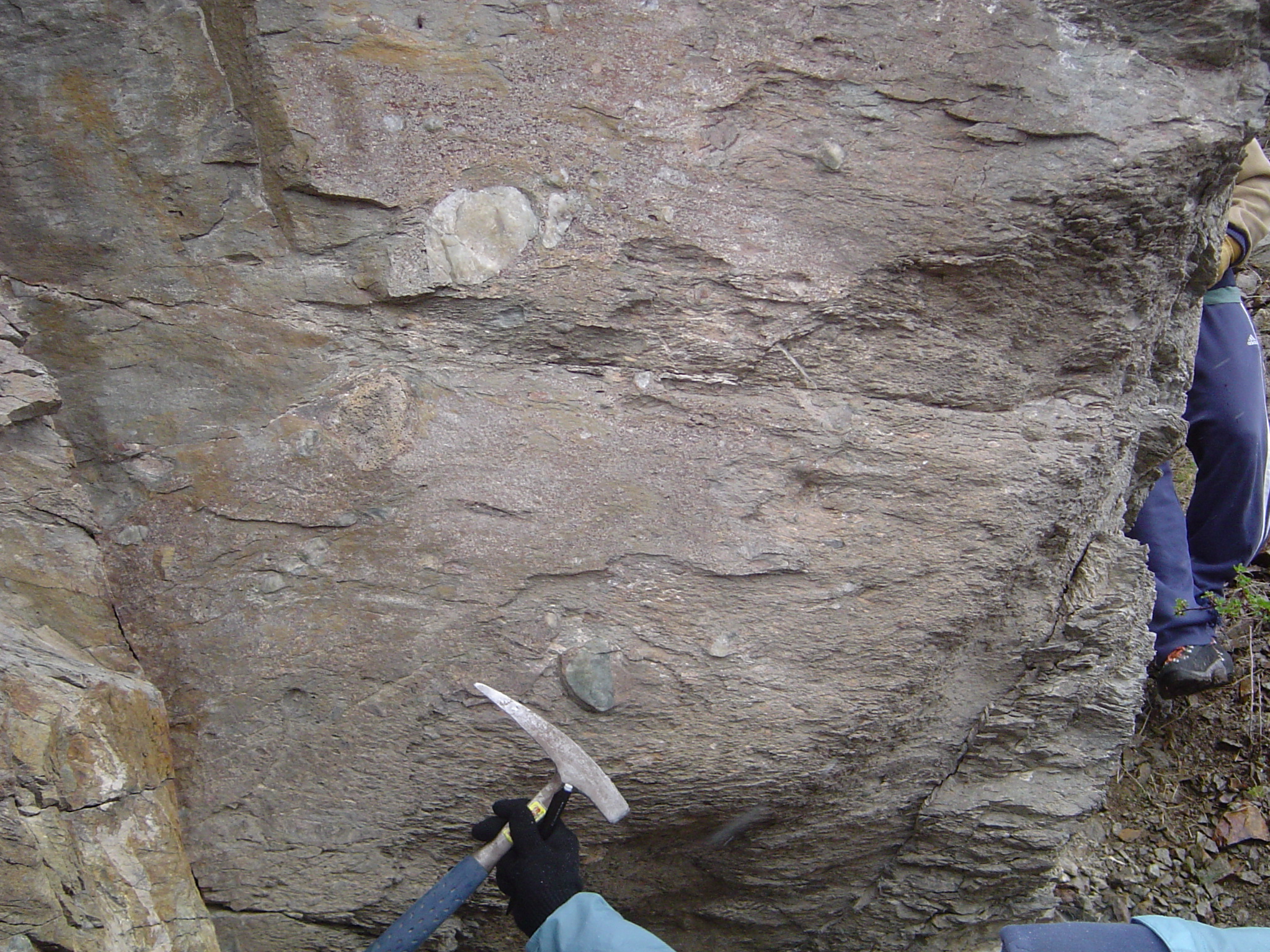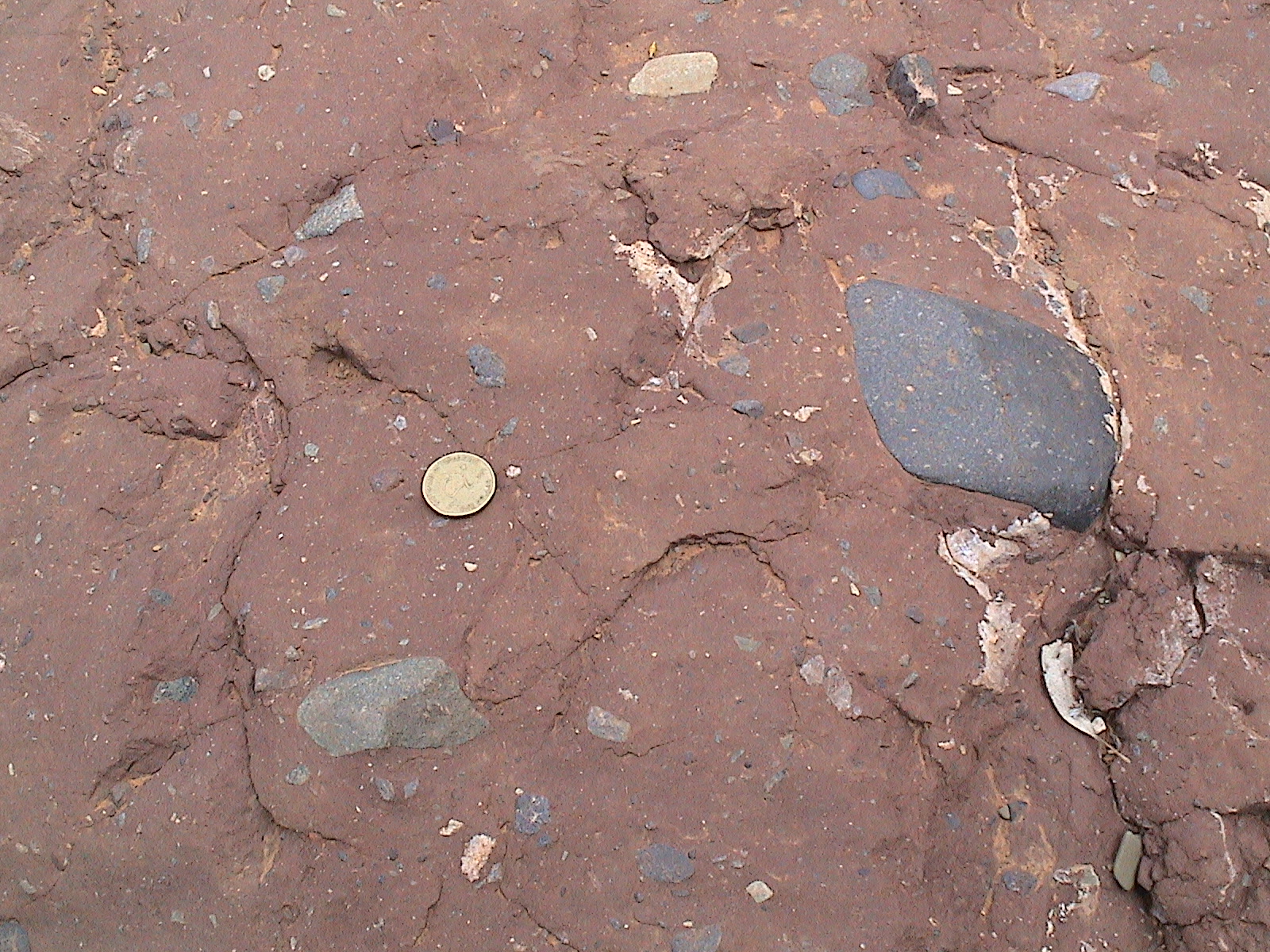Diamictite on:
[Wikipedia]
[Google]
[Amazon]



 Diamictite (; from
Diamictite (; from
Huber, H., Koeberl, C., McDonald, I., Reimold, W.U.: ''Geochemistry and petrology of Witwatersrand and Dwyka diamictites from South Africa: Search for an extraterrestrial component.'' Geochimica et Cosmochimica Acta, Vol. 65, No. 12, pp. 2007–2016, 2001. (pdf 470 Kb)
/ref> * glacial origin ** meltwater flow deposition ** unsorted
Illustration of a Canadian diamictite
Sedimentary rocks
Ancient Greek
Ancient Greek includes the forms of the Greek language used in ancient Greece and the ancient world from around 1500 BC to 300 BC. It is often roughly divided into the following periods: Mycenaean Greek (), Dark Ages (), the Archaic pe ...
''δια'' (dia-): ''through'' and ''µεικτός'' (meiktós): ''mixed'') is a type of lithified sedimentary rock
Sedimentary rocks are types of rock that are formed by the accumulation or deposition of mineral or organic particles at Earth's surface, followed by cementation. Sedimentation is the collective name for processes that cause these particles ...
that consists of nonsorted to poorly sorted terrigenous sediment containing particles that range in size from clay
Clay is a type of fine-grained natural soil material containing clay minerals (hydrous aluminium phyllosilicates, e.g. kaolin, Al2 Si2 O5( OH)4).
Clays develop plasticity when wet, due to a molecular film of water surrounding the clay pa ...
to boulders, suspended in a matrix
Matrix most commonly refers to:
* ''The Matrix'' (franchise), an American media franchise
** '' The Matrix'', a 1999 science-fiction action film
** "The Matrix", a fictional setting, a virtual reality environment, within ''The Matrix'' (franchi ...
of mudstone
Mudstone, a type of mudrock, is a fine-grained sedimentary rock whose original constituents were clays or muds. Mudstone is distinguished from '' shale'' by its lack of fissility (parallel layering).Blatt, H., and R.J. Tracy, 1996, ''Petrology.' ...
or sandstone
Sandstone is a clastic sedimentary rock composed mainly of sand-sized (0.0625 to 2 mm) silicate grains. Sandstones comprise about 20–25% of all sedimentary rocks.
Most sandstone is composed of quartz or feldspar (both silicat ...
. The term was coined by Richard Foster Flint and others as a purely descriptive term, devoid of any reference to a particular origin.Flint, R.F., J.E. Sanders, and J. Rodgers (1960) ''Diamictite, a substitute term for symmictite'' Geological Society of America Bulletin. 71(12):1809–1810. Some geologist
A geologist is a scientist who studies the solid, liquid, and gaseous matter that constitutes Earth and other terrestrial planets, as well as the processes that shape them. Geologists usually study geology, earth science, or geophysics, althou ...
s restrict the usage to nonsorted or poorly sorted conglomerate
Conglomerate or conglomeration may refer to:
* Conglomerate (company)
* Conglomerate (geology)
* Conglomerate (mathematics)
In popular culture:
* The Conglomerate (American group), a production crew and musical group founded by Busta Rhymes
** ...
or breccia
Breccia () is a rock composed of large angular broken fragments of minerals or rocks cemented together by a fine-grained matrix.
The word has its origins in the Italian language, in which it means "rubble". A breccia may have a variety of ...
that consists of sparse, terrigenous gravel
Gravel is a loose aggregation of rock fragments. Gravel occurs naturally throughout the world as a result of sedimentary and erosive geologic processes; it is also produced in large quantities commercially as crushed stone.
Gravel is classifi ...
suspended in either a mud or sand matrix. Tucker, M.E. (2003) ''Sedimentary Rocks in the Field'' John Wiley & Sons, Ltd., New York, New York. 244 pp.
Unlithified diamictite is referred to as diamicton.
The term diamictite is often applied to nonsorted or poorly sorted, lithified glacial deposits such as glacial tillite and boulder clay, and diamictites are often mistakenly interpreted as having an essentially glacial origin (see Snowball Earth
The Snowball Earth hypothesis proposes that, during one or more of Earth's icehouse climates, the planet's surface became entirely or nearly entirely frozen. It is believed that this occurred sometime before 650 M.Y.A. (million years ago) du ...
). The most common origin for diamictites, however, is deposition by submarine mass flows like turbidites and olistostromes in tectonically active areas, and they can be produced in a wide range of other geological conditions. Possible origins include:Eyles, N.; Januszczak, N. (2004). "’Zipper-rift’: A tectonic model for Neoproterozoic glaciations during the breakup of Rodinia after 750 Ma". Earth-Science Reviews 65 (1-2): 1-73. (pdf 4 Mb)/ref> * glacial origin ** meltwater flow deposition ** unsorted
moraine
A moraine is any accumulation of unconsolidated debris ( regolith and rock), sometimes referred to as glacial till, that occurs in both currently and formerly glaciated regions, and that has been previously carried along by a glacier or ice sh ...
glacial till
** basal melt-out
** ice rafted sediments deposited by melting icebergs or disintegrating ice sheets ( dropstones)
* volcanic
A volcano is a rupture in the crust of a planetary-mass object, such as Earth, that allows hot lava, volcanic ash, and gases to escape from a magma chamber below the surface.
On Earth, volcanoes are most often found where tectonic plat ...
origin
** lahar
A lahar (, from jv, ꦮ꧀ꦭꦲꦂ) is a violent type of mudflow or debris flow composed of a slurry of pyroclastic material, rocky debris and water. The material flows down from a volcano, typically along a river valley.
Lahars are extr ...
s
** lahar mass flows entering the ocean
* marine
Marine is an adjective meaning of or pertaining to the sea or ocean.
Marine or marines may refer to:
Ocean
* Maritime (disambiguation)
* Marine art
* Marine biology
* Marine debris
* Marine habitats
* Marine life
* Marine pollution
Military ...
origin
** debris flow
** turbiditic
A turbidity current is most typically an underwater current of usually rapidly moving, sediment-laden water moving down a slope; although current research (2018) indicates that water-saturated sediment may be the primary actor in the process. T ...
olistostromes
** mixing of sediments by submarine landslides
* tectonic
Tectonics (; ) are the processes that control the structure and properties of the Earth's crust and its evolution through time. These include the processes of mountain building, the growth and behavior of the strong, old cores of continents ...
origin
** fault gouge
* erosion
Erosion is the action of surface processes (such as water flow or wind) that removes soil, rock, or dissolved material from one location on the Earth's crust, and then transports it to another location where it is deposited. Erosion is d ...
al origin
** regolith, in the form of a debris flow
** other mass wasting events
* extraterrestrial origin
** impact breccia
Breccia () is a rock composed of large angular broken fragments of minerals or rocks cemented together by a fine-grained matrix.
The word has its origins in the Italian language, in which it means "rubble". A breccia may have a variety of di ...
References
Further reading
* Deynoux, M., et al. (Editors) (2004) ''Earth's Glacial Record'', Cambridge University Press, pp. 34–39 {{ISBN, 0-521-54803-9External links
Illustration of a Canadian diamictite
Sedimentary rocks